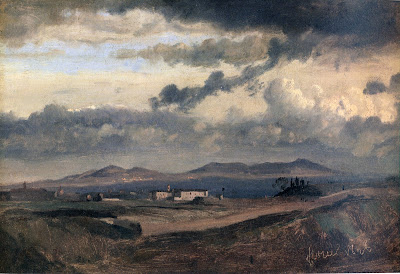 |
| Corot, Le petit chaville, 1823-25, Ashmolean |
I’ve been reading about landscape art, based on the recent True to Nature exhibition at the Fitzwilliam Museum. It was only after visiting the exhibition that I realised that all the works were oil sketches, which turns out to be a genre in its own right. Several of those pictures had all the freshness and lightness of a watercolour, and my assumption, since the sketches had been done in the open air, that they were done using relatively portable tools like watercolour paint.
 |
| Valenciennes, Pierre-Henri de, Study of clouds over the Roman campagna, 1782-85, NGA |
On reading the catalogue, the oil sketch from nature seems to have existed back to the 18th century, and even before, if we include the pen and ink sketches done by Claude, although it seems to have been a private form of art, not intended for public display. Only relatively recently has there been an interested in collecting and showing these works, with the Fitzwilliam one of the first to collect them. The catalogue mentions exhibitions in 1969, 1977, and 1980 (at the Fitzwilliam), so the oil sketch is today hardly a secret.
It seems incredible that here is an alternative tradition, as it were, that was known to art historians – Clark writes about it in Landscape into Art, back in 1949 – but it was not taken seriously as part of landscape painting history. Why was this? Perhaps fine art curators and writers were, for many years, obsessed with gold-leaf frames: formal kinds of art that sold for high prices and reflected well on the collection that owned them. Sketches and drawings not intended for sale were simply not taken so seriously, even when by the same artists who executed the more highly prized formal works (and put fancy frames around them).
 |
| Corot, Convent of Sant'Onofrio on the Janiculum, 1826, Fitzwilliam |
The classic example is Corot. Here is Clark on Corot’s first trip to Italy:
Corot went to Rome as a student in 1825 … with the intention of following in the footsteps of Poussin and of the recent master of classic landscape, Pierre Henri Valenciennes. The sketches he made from nature were undertaken simply as material for later compositions. We must remember that all the classic landscape painters of the time made such studies - those of Valenciennes himself are of considerable beauty – but they were not considered of more than private or professional interest, and were generally destroyed … the sketches made on this first journey are, in some ways, the most remarkable he ever did … looking at these crystalline visions it is hard to believe that they were practically never seen in Corot’s lifetime
Landscape into Art, chapter five “The Natural Vision”
Just as with Constable, these early sketches are today often more highly prized than Corot’s more formal exhibition pieces. The True to Nature exhibition reveals many, many other artists whose sketches turn out not to be lost, but very evidently part of the naturalistic landscape tradition. Why does Clark not make more of them in his history of landscape art?



No comments:
Post a Comment